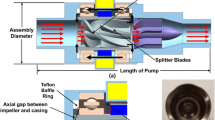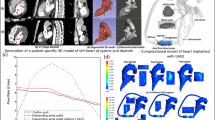Abstract
Left ventricular assist devices (LVAD) emerges as an effective clinical device providing life-saving support to heart patients. The design of blood pump of an LVAD involves incredible accuracy and thorough understanding of hemodynamics to mimic the functionality of a healthy ventricle. This work studies hemodynamics around an LVAD and proposes an improved model of axial blood pump for cardiac circulation without any hemolysis complications through numerical investigations. A three-dimensional study on different versions of the impeller with three curved blades (pump I) and spiral blade (pump II) is carried out by utilizing computational fluid dynamics software ANSYS-CFX at a range of rotational speeds and flow rates. The non-Newtonian blood flow through pump is modeled by using Bird-Carreau model. To capture the change in the flow field near the rotating blade, a transient blade row model was employed. The proposal of spiral blade impeller was found to be more compatible as per the hemolytic performance. It considerably reduces the blood damage to two times lesser value than that by pump I and also improves the quality blood flow field. The spiral blade provides a guiding path to the blood particle and avoids mixing of different bloodstreams, thus reducing the eddy losses.

The graphical abstract shows the performance enhancement of the axial blood pump. The model proposed by Peng et al. (Comput Methods Biomech Biomed Engin 17(7):723–727, 2014) has been upgraded to two new versions by redesigning its impeller. Proposed design (pump II) shows improvement in pressure distribution (a) and reduction in hemolysis (in the case of pump II) index (b).

















Similar content being viewed by others
References
Lloyd-Jones D, Adams R, Carnethon M, De Simone G, Ferguson TB, Flegal K et al (2009) Heart disease and stroke statistics 2009 update: a report from the American heart association statistics committee and stroke statistics subcommittee. Circulation 119:e21–e181
Wiedemann D, Haberl T, Riebandt J, Simon P, Laufer G, Zimpfer D, Laufer G (2014) Ventricular assist devices- evolution of surgical heart failure treatment. Euro Cardio R 9(1):54–58
Bumrungpetch J, Mechanism design of ventricular assist device. Ph.D. Thesis, Queensland University of Technology, Australia, 2016
Slaughter MS, Rogers JG, Milano CA, Russell SD, Conte JV, Feldman D, Sun B, Tatooles AJ, Delgado RM 3rd, Long JW, Wozniak TC, Ghumman W, Farrar DJ, Frazier OH, HeartMate II Investigators (2009) Advanced heart failure treated with continuous-flow left ventricular assist device. N Engl J Med 361(23):2241–2251
Patel H, Madanieh R, Kosmas CE, Vatti SK, Vittorio T (2015) Complications of continuous-flow mechanical circulatory support devices. Clin Med Insights Cardiol 9(2):15–21
Ravichandran AK, Parker J, Novak E, Joseph SM, Schilling JD, Ewald GA, Silvestry S (2014) Hemolysis in left ventricular assist device: a retrospective analysis of outcomes. J Heart Lung Transplant 33(1):44–50
Zhu L, Zhang X, Yao Z (2010) Shape optimization of the diffuser blade of an axial blood pump by computational fluid dynamics. Artif Organs 34(3):185–192
Yu H, Jangia G, Thevenin D (2015) Computational fluid dynamics-based design optimization method for Archimedes screw blood pumps. Artif Organs 40(4):341–352
Kapadia JY, Pierce KC, Poupore AK, Throckmorton AL (2010) Hydraulic testing of intravascular axial flow blood pump designs with a protective cage of filaments for mechanical cavopulmonary assist. ASAIO J 56(1):17–23
Chen Z, Jena SK, Giridharan GA, Sobieski MA, Koenig SC, Slaughter MS, Griffith BP, Wu ZJ (2019) Shear stress and blood trauma under constant and pulse-modulated speed CF-VAD operations: CFD analysis of the HVAD. Med Biol Eng Comput 55:167–178
Su B, Chua LP, Wang X (2011) Validation of an axial flow blood pump: computational fluid dynamics results using particle image velocimetry. Artif Organs 36(4):359–367
Song G, Chua LK, Lim TM (2009) Numerical study of a bio-centrifugal blood pump with straight impeller blade profiles. Artif Organs 34(2):98–104
Nammakie E, Niroomand-Oscuii H, Koochaki M, Ghalichi F (2017) Computational fluid dynamics-based study of possibility of generating pulsatile blood flow via a continuous-flow VAD. Med Biol Eng Comput 55:167–178
Untaroiu A, Throckmorton AL, Patel SM, Wood HG, Allaire PE, Olsen DB (2005) Numerical and experimental analysis of an axial flow left ventricular assist device: the influence of the diffuser on overall pump performance. Artif Organs 29(7):581–591
Zhang Y, Zhan Z, Gui XM, Sun HS, Zhang H, Zheng Z, Zhou JY, Zhu XD, Li GR, Hu SS, Jin DH (2008) Design optimization of an axial blood pump with computational fluid dynamics. ASAIO J 54(2):150–155
Chen Z, Yao Z, Zhu L, Zhang X (2013) Hemolysis analysis of axial blood pumps with various structure impellers. J Mech Med Biol 13(4):1350054
Toptop K, Kadipasaoglu KA (2013) Design and numeric evaluation of a novel axial-flow left ventricular assist device. ASAIO J 59(3):230–239
Peng Y, Wu Y, Tang X, Liu W, Chen D, Gao T, Xu Y, Zeng Y (2014) Numerical simulation and comparative analysis of flow field in axial blood pumps. Comput Methods Biomech Biomed Engin 17(7):723–727
Lanotte L, Mauer J, Mendez S, Fedosov DA, Fromental JM, Claveria V, Nicoud F, Gompper G, Abkarian M (2016) Red cells’ dynamic morphologies govern blood shear thinning under microcirculatory flow conditions. Proc Natl Acad Sci U S A 113:13289–13294
Fraser KH, Zhang T, Taskin ME, Griffith BP, Wu ZJ (2018) A quantitative comparison of mechanical blood damage parameters in rotary ventricular assist devices: shear stress, exposure time and hemolysis index. J Biomech Eng 134(8):081002
Yu J, Zhang X (2016) Hydrodynamic and hemolysis analysis on distance and clearance between impeller and diffuser of axial blood pump. J Mech Med Biol 16(1):1650014
Chen Z, Jena SK, Giridharan GA, Koenig SC, Slaughter MS, Griffith BP, Wu Z (2018) Flow features and device-induced blood trauma in CF-VADs under a pulsatile blood flow condition: a CFD comparative study. Int J Numer Meth Biomed Engng 34:e2924
Leverett LB, Hellums JD, Alfrey CP, Lynch EC (1972) Red blood cell damage by shear stress. Biophys J 12(3):257–273
Demir O, Biyikli E, Lazoglu I, Kucukaksu S (2011) Design of centrifugal blood pump: heart turica centrifugal. Artif Organs 35(7):720–725
Wannawat P, Foojinphan N, Khienwad T, Naiyanetr P (2017) The study of various impeller design for centrifugal blood pump using computer method. In: Proceedings of the IASTED International Conference Biomedical Engineering (Biomed 2017). IEEE, Innsbruck Austria, pp 247–253
Cho YI, Kensey KR (1991) Effects of the non-Newtonian viscosity of blood on flows in a diseased arterial vessel. Part 1: steady flows. Biorheology 28(3–4):241–262
Blackshear PL, Blackshear GL (1987) Mechanical hemolysis. In: Skalak R, Chien S (eds) Handbook of bioengineering. McGraw-Hill, New York, pp 15.1–15.19
Anderson JB, Wood HG, Allaire PE, McDaniel JC, Olsen DB, Bearnson G (2000) Numerical studies of blood shear and washing in a continuous flow ventricular assist device. ASAIO J 46(4):486–494
Wurzinger LJ, Opitz R, Eckstein H (1986) Mechanical blood trauma: an overview. Angiology 38:81–97
Giersiepen M, Wurzinger LJ, Opitz R, Reul H (1990) Estimation of shear stress-related blood damage in heart valve prostheses in vitro comparison of 25 aortic valves. Int J Artif Organs 13(5):300–306
Taskin ME, Fraser KH, Zhang T, Gellman B, Fleischli A, Dasse KA, Griffith BP, Wu ZJ (2010) Computational characterization of flow and hemolytic performance of the UltraMag blood pump for circulatory support. Artif Organs 34(12):1099–1113
Faghig MM, Sharp MK (2016) Extending the power-law hemolysis model to complex flows. J Biomech Eng 138(12):124504–124501
American Society for Testing and Materials (1997) Standard practice for assessment of hemolysis in continuous flow blood pumps. Standard F 1841–1897
Ren L, Gu B, Du Y, Wu X, Liu X, Wang H, Jiang L, Guo Y, Wang J (2014) Hemoglobin in normal range, the lower the better? Evidence from a study from Chinese community-dwelling participants. J Thorac Dis 6(5):477–482
Su B, Chua LP, Zhong L (2013) Numerical studies of an axial flow blood pump with different diffuser designs. J Mech Med Biol 13(03):1350029
Shibeshi SS, Collins WE (2005) The rheology of blood flow in a branched arterial system. Appl Rheol 15(6):398–405
Nguyen C (2005) Turbulence Modeling. MIT 1(8):1–6
Sang X, Zhou X (2017) Investigation of hydraulic performance in an axial-flow blood pump with different guide vane outlet angle. Adv Mech Eng 9(8):1–11
Potter PA, Perry AG (2016) Stockert P, Hall A. Fundamental of Nursing, Elsevier Health Sciences
Down LA, Papavassiliou DV, O'Rear EA (2011) Significance of extensional stresses to red blood cell lysis in a shearing flow. Ann Biomed Eng 39:1632
De Wachter DS, Verdonck PR, Verhoeven RF, Hombrouckx RO (1996) Red cell injury assessed in a numerical model of a peripheral dialysis needle. ASAIO J 42:524–529
Funding
This research work was supported by the Ministry of Human Resource Development (MHRD) and Indian Council of Medical Research (ICMR) under the IMPRINT scheme (award number 3-18/2015-TSI).
Author information
Authors and Affiliations
Corresponding author
Additional information
Publisher’s note
Springer Nature remains neutral with regard to jurisdictional claims in published maps and institutional affiliations.
Rights and permissions
About this article
Cite this article
Kannojiya, V., Das, A.K. & Das, P.K. Proposal of hemodynamically improved design of an axial flow blood pump for LVAD. Med Biol Eng Comput 58, 401–418 (2020). https://doi.org/10.1007/s11517-019-02097-5
Received:
Accepted:
Published:
Issue Date:
DOI: https://doi.org/10.1007/s11517-019-02097-5




